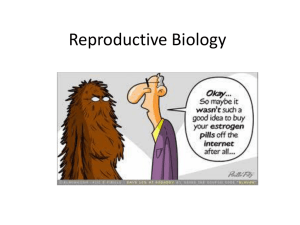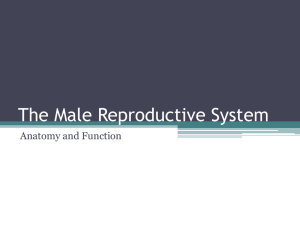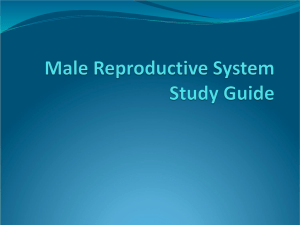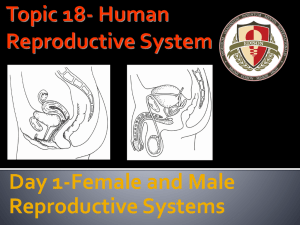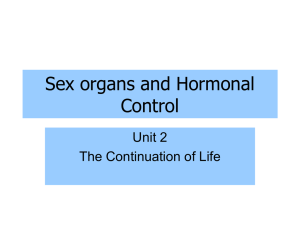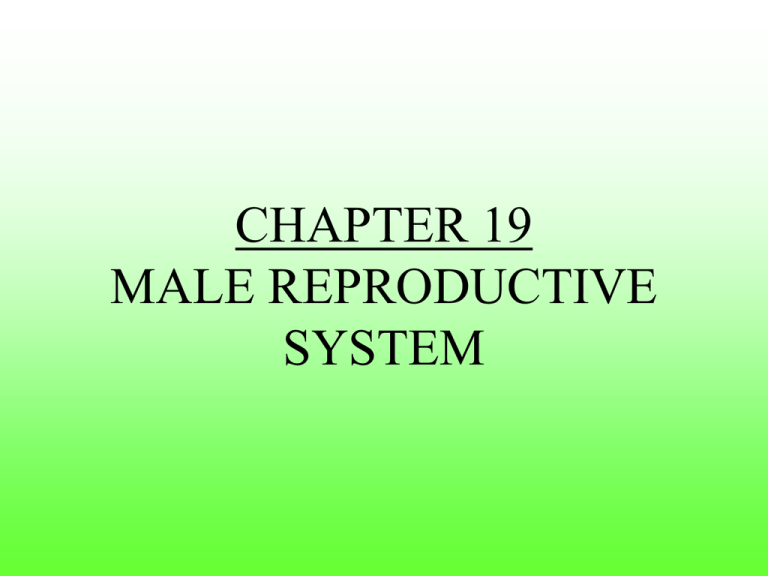
CHAPTER 19
MALE REPRODUCTIVE
SYSTEM
Male Reproductive System
• MALE REPRODUCTIVE SYSTEM
Testosterone- male sex hormone
Two Main Functions of the Male System
1. Produce Sperm – male reproductive cells
- Do not start to produce sperm until puberty (Ages 9 to 14)
2. Transfer of sperm to the female’s body
during sexual intercourse
External male reproductive organs
• Testes- male sex glands that manufacture testosterone and
produce sperm.
- Produce 500 million sperm per day
- Testes are enclosed in the scrotum- sac that holds the
testes and hangs outside the body. The scrotum’s function is to
regulate the temperature of sperm. The optimal temperature for
sperm production is 3 to 4 degrees below the body temp of 98.6
degrees.
• Penis –Tube like organ that functions in sexual reproduction,
sexual pleasure and elimination of body wastes.
- composed of spongy tissues that contains many blood
vessels
- When blood flow is increased, the penis becomes
enlarged and this can happen for no reason at all.
- Males of every age get erections
External male reproductive organs
• Epididymis- Temporary storage facility for sperm. Highly coiled
tube Structure located on the back side of each teste. It takes
sperm 64 days to fully mature in the epididymis.
• Ejaculation – the release of semen- (mixture of sperm and fluids
from the seminal vesicles, prostate gland, and cowper’s gland.).
During ejaculation there is a teaspoon of semen released,
containing 300 to 400 million sperm.
– A male may feel some discomfort and pain if sexual arousal lasts for a
period of time and he does not ejaculate, due to build up of blood and fluid
and muscular pressure. The erection will eventually go away. This
condition is not harmful in any way to the male.
• At birth the tip of the penis is covered with a fold of skin called a
foreskin.
- Some parents choose circumcision – surgical removal of
the foreskin
Internal male reproductive organs
• Play a role of the delivery of the sperm.
• These organs include:
– Vas Deferens- 18 inch tubes that connects the epididymis
to the urethra. Propel the sperm forward in powerful spurts
just before ejaculation. It is here that the sperm mix with the
fluid produced by the seminal vesicles.
– Seminal Vesicles- produce fluid that mixes with sperm.
• This fluid contains nutrients and provides nourishment for the sperm.
– Prostate Gland – The size of a chestnut or walnut.
Produces a milky, alkaline fluid that mixes with sperm and
makes up a major portion of the semen. This solution helps
protect the sperm by neutralizing the acidic environment of
the urethra and the vagina in the female.
Internal male reproductive organs
– Cowper’s Gland – Two pea-sized organs. Secretes a
clear, sticky fluid that is thought to cleanse the urethra
of acid from urine and helps lubricate the urethra for
safe passage of sperm.
• Some of the clear fluid from the Cowper’s gland is released
before the semen is released. This secretion causes droplets of
fluid to form on the end of the penis before ejaculation. These
droplets of fluid can contain sperm. That means pregnancy can
occur from the secretions of the Cowper’s glands, even if
semen never leaves the penis.
– Semen – a mixture of sperm with the fluid produced
from the seminal vesicles, prostate gland and the
Cowper's gland.
– Urethra – tubelike organ that travels through the penis.
• Semen and urine cannot leave the body at the same time.
Concerns about the Male Repro. System
1. Nocturnal Emissions- “Wet Dream” Fluid Buildup
2. Hernia – intestine pushing through into the scrotum
3. Sterility – Sperm is weak, malformed, sparse, nonexistent or unable to join the ovum
4. Testicular Cancer – Most common form of cancer in
males. Ages 15 to 34
5. Prostate Problems – include cancer, enlarged
(difficulty and frequent urinating)

